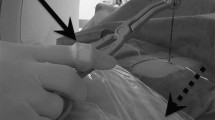Abstract
Purpose
Radioembolization of liver cancer with 90Y-loaded microspheres is increasingly used but data regarding hospital staff exposure are scarce. We evaluated the radiation exposure of medical staff while preparing and injecting 90Y-loaded glass and resin microspheres especially in view of the increasing use of these products.
Methods
Exposure of the chest and finger of the radiopharmacist, nuclear medicine physician and interventional radiologist during preparation and injection of 78 glass microsphere preparations and 16 resin microsphere preparations was monitored. Electronic dosimeters were used to measure chest exposure and ring dosimeters were used to measure finger exposure.
Results
Chest exposure was very low for both products used (<10 μSv from preparation and injection). In our experience, finger exposure was significantly lower than the annual limit of 500 mSv for both products. With glass microspheres, the mean finger exposure was 13.7 ± 5.2 μSv/GBq for the radiopharmacist, and initially 17.9 ± 5.4 μSv/GBq for the nuclear medicine physician reducing to 13.97 ± 7.9 μSv/GBq with increasing experience. With resin microspheres, finger exposure was more significant: mean finger exposure for the radiopharmacist was 295.1 ± 271.9 μSv/GBq but with a reduction with increasing experience to 97.5 ± 35.2 μSv/GBq for the six most recent dose preparations. For administration of resin microspheres, the greatest mean finger exposure for the nuclear medicine physician (the most exposed operator) was 235.5 ± 156 μSv/GBq.
Conclusion
Medical staff performing 90Y-loaded microsphere radioembolization procedures are exposed to safe levels of radiation. Exposure is lower than that from treatments using 131I-lipiodol. The lowest finger exposure is from glass microspheres. With resin microspheres finger exposure is acceptable but could be optimized in accordance with the ALARA principle, and especially in view of the increasing use of radioembolization.



Similar content being viewed by others
References
Salem R, Lewandowski RJ, Mulcahy MF, Wang E, Riaz A, Ryu RK, et al. Radioembolization for hepatocellular carcinoma using yttrium-90 microspheres: a comprehensive report of long-term outcomes. Gastroenterology. 2010;138(1):52–64.
Sangro B, Carpanese L, Cianni R, Golfieri R, Gasparini D, Ezziddin S, et al. Survival after yttrium-90 resin microsphere radioembolization of hepatocellular carcinoma across Barcelona clinic liver cancer stages: a European evaluation. Hepatology. 2011;54(3):868–78.
Gray B, Van Hazel G, Hope M, Burton M, Moroz P, Anderson J, et al. Randomised trial of SIR-Spheres plus chemotherapy vs. chemotherapy alone for treating patients with liver metastases from primary large bowel cancer. Ann Oncol. 2001;12(12):1711–20.
Garin E, Lenoir L, Edeline J, Laffont S, Mesbah H, Porée P, et al. Boosted selective internal radiation therapy with 90Y-loaded glass microspheres (B-SIRT) for hepatocellular carcinoma patients: a new personalized promising concept. Eur J Nucl Med Mol Imaging. 2013;40(7):1057–68.
Bernal P, Raoul JL, Stare J, Sereegotov E, Sundram FX, Kumar A, et al. International Atomic Energy Agency-sponsored multination study of intra-arterial rhenium-188-labeled lipiodol in the treatment of inoperable hepatocellular carcinoma: results with special emphasis on prognostic value of dosimetric study. Semin Nucl Med. 2008;38(2):S40–5.
Smits ML, Nijsen JF, van den Bosch MA, Lam MG, Vente MA, Mali WP, et al. Holmium-166 radioembolisation in patients with unresectable, chemorefractory liver metastases (HEPAR trial): a phase 1, dose-escalation study. Lancet Oncol. 2012;13(10):1025–34.
Gibbs P, Heinemann V, Sharma NK, Findlay MPN, Ricke J, Gebski V, et al. 2015 ASCO Annual Meeting. J Clin Oncol. 2015;33 (Suppl). Abstract 3502.
Garin E, Laffont S, Rolland Y, Olivié D, Lecloirec J, Herry JY, et al. Safe radiation exposure of medical personnel using simple radioprotection means while administering 131I-lipiodol therapy for hepatocellular carcinoma. Nucl Med Commun. 2003;24:671–8.
Sirtex Medical. Package insert: SIR-Spheres® microspheres (yttrium-90 microspheres). Woburn, MA: Sirtex Medical; 2014. http://www.sirtex.com/media/29845/ssl-us-10.pdf.
Garin E, Lenoir L, Rolland Y, Edeline J, Mesba H, Laffont S, et al. 99mTc-MAA SPECT/CT based dosimetry accurately predicts tumour response and survival in HCC patients treated with 90Y-loaded glass microspheres: preliminary results. J Nucl Med. 2012;53(2):255–63.
Lancelot S, Guillet B, Sigrist S, Bourrelly M, Waultier S, Mundler O, et al. Exposure of medical personnel to radiation during radionuclide therapy practices. Nucl Med Commun. 2008;29(4):405–10.
Ginjaume M, Pérez S, Ortega X. Improvements in extremity dose assessment for ionising radiation medical applications. Radiat Prot Dosimetry. 2007;125(1-4):28–32.
Pereira MF, Alves JG, Sarmento S, Santos JA, Sousa MJ, Gouvêa M, et al. Preliminary assessment of the dose to the interventional radiologist in fluoro-CT-guided procedures. Radiat Prot Dosimetry. 2011;144(1-4):448–52.
Acknowledgments
The authors thank the LABEX Iron for its support.
Author information
Authors and Affiliations
Corresponding author
Ethics declarations
Funding
E. Garin received research grants and speaker honoraria from BTG UK Ltd.
Conflicts of interest
E. Garin is a consultant for BTG UK Ltd
Informed consent
Formal consent was not required for this study.
Rights and permissions
About this article
Cite this article
Laffont, S., Rolland, Y., Ardisson, V. et al. Occupational radiation exposure of medical staff performing 90Y-loaded microsphere radioembolization. Eur J Nucl Med Mol Imaging 43, 824–831 (2016). https://doi.org/10.1007/s00259-015-3277-1
Received:
Accepted:
Published:
Issue Date:
DOI: https://doi.org/10.1007/s00259-015-3277-1




